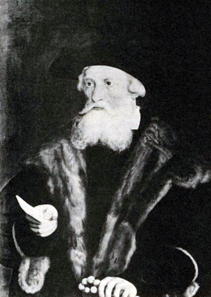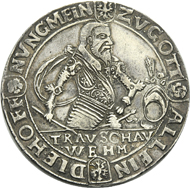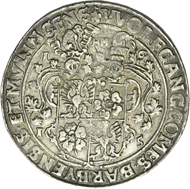These were difficult times for all of the minor imperial knights and imperial counts in the Holy Roman Empire of the German Nation. If one’s territory was too small, the revenue would not match a nobleman’s expenditures, due largely in part to the matter of attending to one’s status: generous gifts, an ostentatious manner, a grand, impressive ancestral seat, and a lifestyle befitting one’s rank – in short, accumulation of debt was essentially a given for any minor nobleman of high standards.
Maintaining these high standards therefore meant locating and availing oneself of diverse sources of income, the surest of which was achieved through the sovereign, even if one didn’t necessarily share his beliefs.
Around the mid 16th century, religious disputes were not yet carried out with the same level of embittered hostility familiar to us from the Thirty Years’ War.
Louis V, Count Palatine. Wikipedia.
Wolfgang II’s father, Wolfgang I, was a personal friend of Luther and, acting out of conviction, had already opened up his land to the Reformation as early as 1540. His son, however, was educated at a Catholic court. Louis V, Count Palatine and one of the most important imperial princes, felt obligated to strike some sort of compromise. Although Catholic himself, he nevertheless allowed reformed services in his territory.
Did Wolfgang feel at ease in the Palatinate? We don’t really know, and sources come up a bit short when it comes to this minor imperial count of an even smaller imperial country. What has been handed down to us, however, is that Wolfgang was just 20 years old when he gained his first experiences in the military. The young prince fought for Charles V against the French king at Metz, which at that time was still a part of the Empire, and also in the bloody Battle of Sievershausen. Although Protestant, later he was to fight for the former adversary, the French king, against the Huguenots. And when he became too old to continue fighting, he had to look for other ways to make money.
Wolfgang II was well over 70 when he came up with the idea of establishing a mint in Barby. This seemed like a secure source of income to him, provided he only had coin values minted whose face value far exceeded the production costs.
The only downside, of course, was that Wolfgang was not in fact permitted to establish a mint. The legal situation was as follows: The Holy Roman Empire of the German Nation was divided into imperial circles. According to imperial law, there were only to be three to four mints within each circle at which everyone with minting privileges were to have their coins minted. At the beginning of the 17th century, the mints for the Upper Saxon Circle, which Barby was a part of, were Berlin, Leipzig, Saalfeld and Stettin. Four mints would have been wonderful and would have allowed for central control, but unfortunately the provision was not enforced. An exception had already been made for the princes who were mining silver in their territory. They were permitted to run their own mint under the control of the mining authority. In the Upper Saxon circle, Saxony made use of this privilege with its Dresden mint.
At any rate, Wolfgang II was not going to let the unstable legal situation deter him from opening and running his own mint. His mint in Barby was in operation at latest by 1611 and almost exclusively produced groschen. Smaller denominations, which mostly circulated on markets within a limited radius, could be manufactured for a much higher profit than large silver coins, which were issued primarily for representative purposes, and mainly by the minting authorities, who had their own silver mines. Of course, there were protests. As early as 1612, the electoral prince of Saxony, on behalf of the country council, called for the closing of the Barby mint once again. A letter to the same effect also went to the Duke of Pomerania and the city of Stralsund, who were also producing coinage in mints not accredited by the empire.
On January 31, 2013, Künker auction house will be putting this unique thaler up for auction with an estimate of 50,000 EUR. This thaler testifies to the life and death of a simple imperial count of the Early Modern Age.
Barby continued minting anyway, and our piece, a unique imperial thaler, dates back to the year of Wolfgang II’s death, 1615. It can be seen in connection with the other thalers and double thalers that also came about in 1615 upon his death, although the coat of arms side is made with the same dies for the other types. These types of stampings, which were passed on as representative gifts, essentially immortalized and perpetuated the glory of the dead; and so, we see Wolfgang II as he most likely would have liked to see himself. He confronts us as a great war hero in three-quarter profile. The armour is finely decorated, and the commander’s coat billows out over the back. Wolfgang holds a commander’s staff in his right hand, and his left is propped up on his ornamental sabre on the side. There’s a jousting helmet before him, a reference to and attribute of the knight’s ideal still prevalent in the 16th century. In the exergue is his motto: ‘Watch whom you trust.’ This motto was borrowed from a well-known Latin emblem, whose explanatory poem, when translated, reads as follows: ‘Even when the swallow, the harbinger of spring, nests under people’s roofs, she does not have unlimited trust in the people. It is equally wrong both to want to trust everyone or not to trust anyone; a wise person stays somewhere closer to the middle of the two. Trust, but first be sure to have a close look at whom you can safely trust; and since one can’t safely trust anyone, trust in God.’ If we choose to believe the inscription on the thaler, this is precisely what Wolfgang did: ‘My hope lies in God alone.’
The reverse is dedicated to the count. His name appears here, as well as his title, the coat of arms, and above it, two decorated jousting helmets with crests. The cipher of year, 1615, is visible in the corners, and the initials of the mint master, Heinrich Meier, are visible in the field above.
For a relatively minor imperial count that sought and found his path among the great happenings of his time, this thaler serves as, to borrow Horace’s expression, a memorial more enduring than ore.
If you want to have a look at the auction material, click here.








